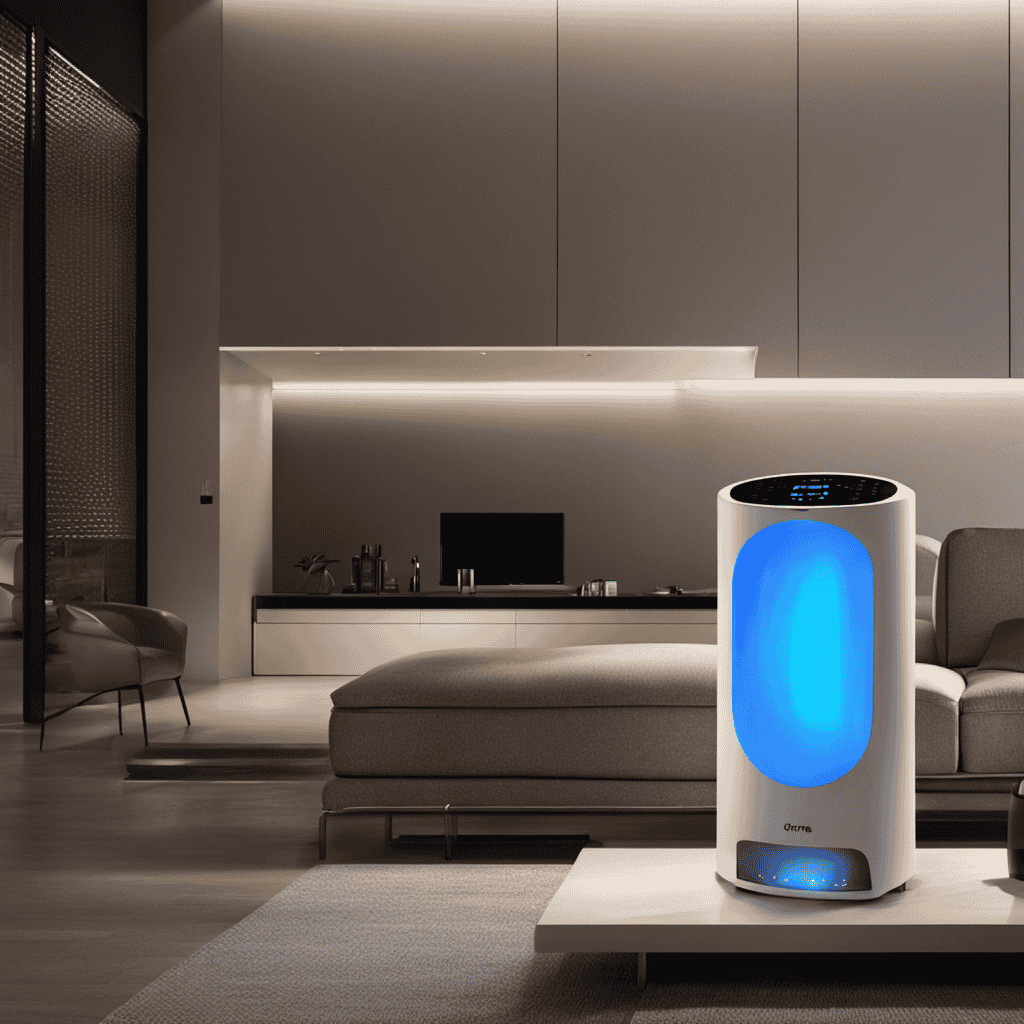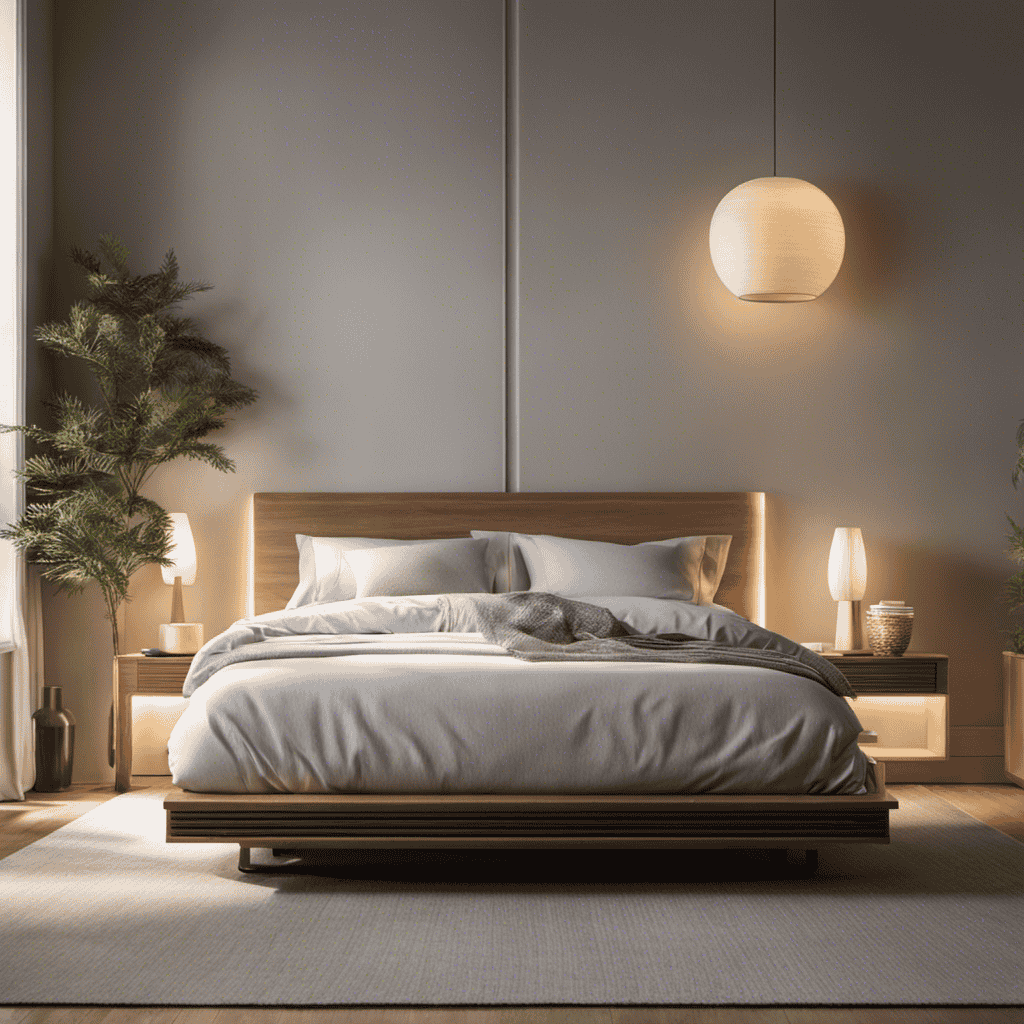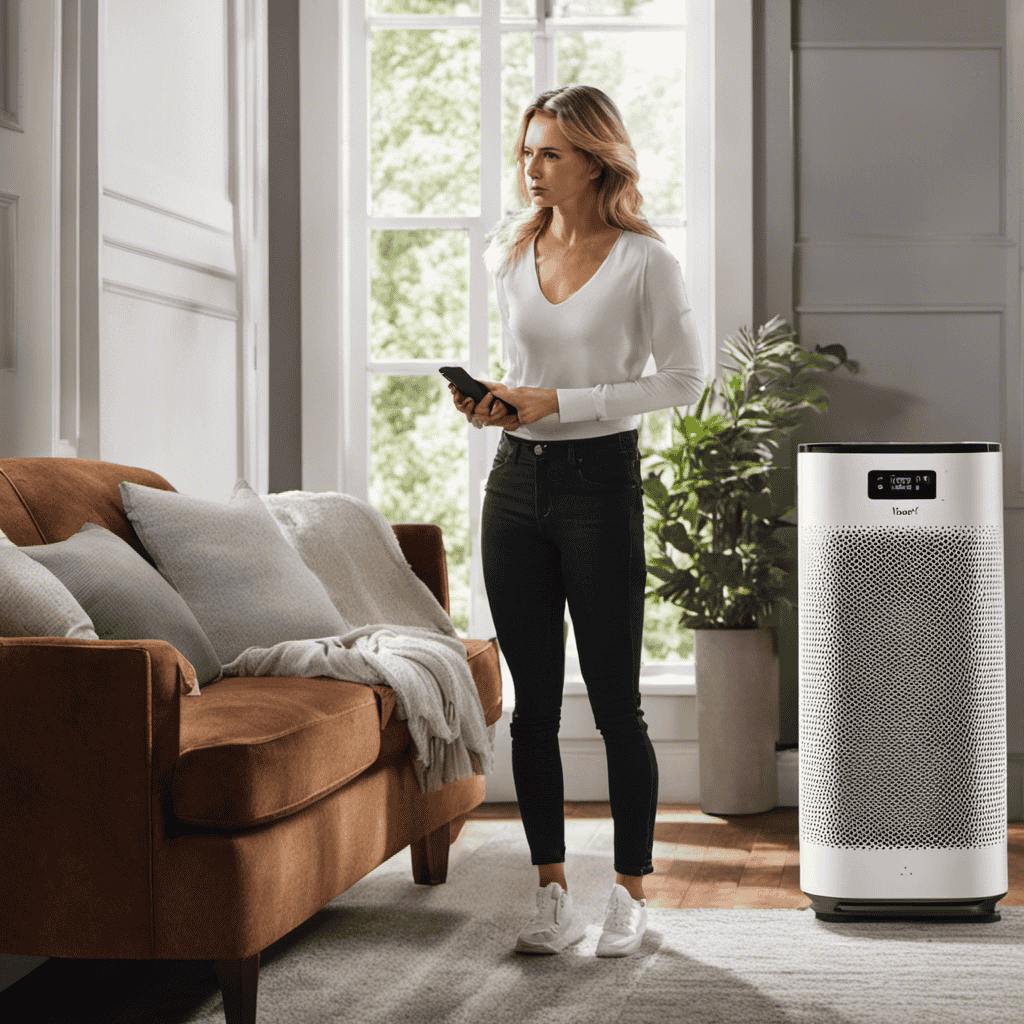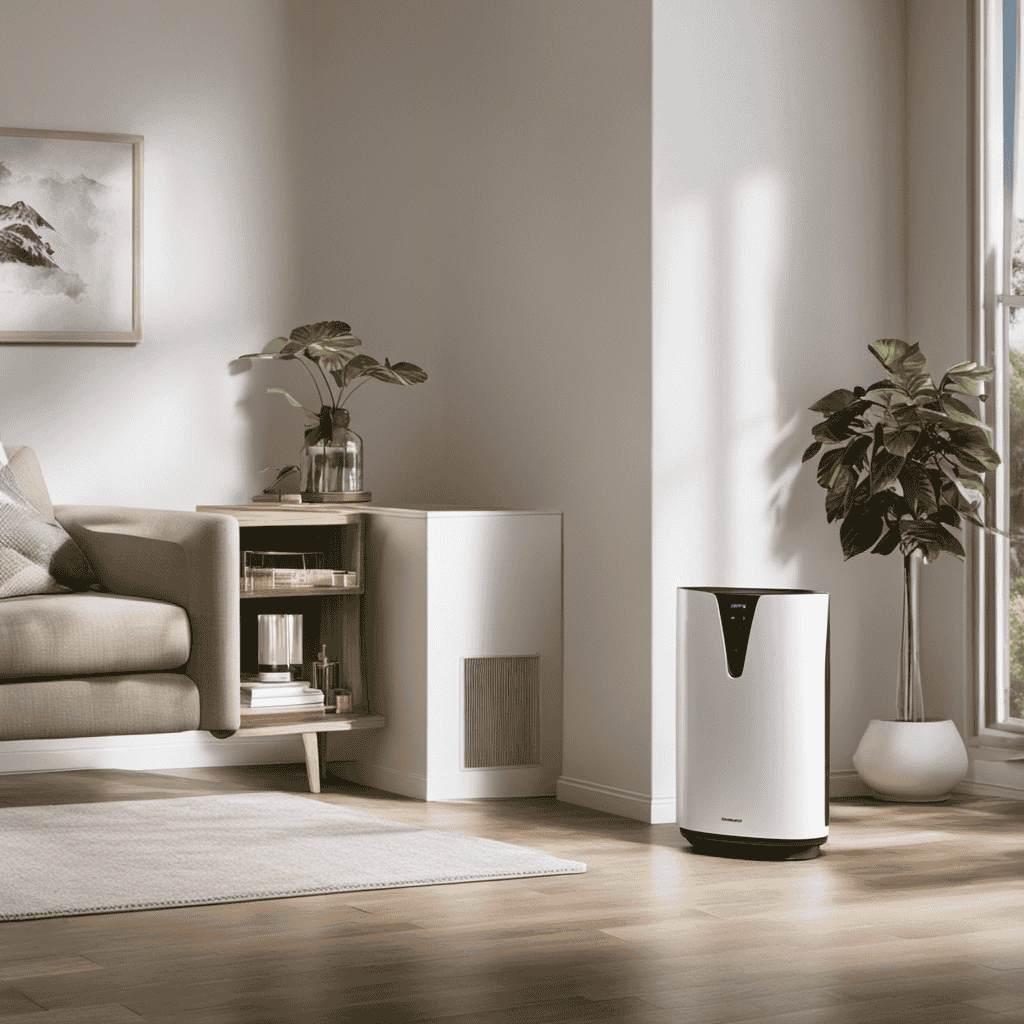As a person with allergies, I understand the challenge of seeking clean, fresh air to breathe. This is why I constantly search for ways to enhance indoor air quality.
One solution that has caught my attention is the air purifier. But what exactly is an air purifier for? In this article, we will delve into the world of air purifiers, exploring how they work, the benefits they offer, and the different types available.
Get ready to discover a breath of fresh air in your home!
Key Takeaways
- Air purifiers remove harmful pollutants from the air, improving indoor air quality and reducing the risk of respiratory diseases.
- They contribute to better sleep quality, allergy management, and overall wellbeing by improving indoor air quality.
- Air purifiers can effectively remove allergens like dust, pollen, pet dander, and mold spores.
- Choosing the right air purifier for the room size and properly maintaining it through regular filter cleaning or replacement is important for optimal performance.
How Does an Air Purifier Work
If you’re wondering how an air purifier works, it uses filters to capture and remove pollutants from the air you breathe. Air purifiers employ advanced technology to improve the air quality in your indoor spaces.
These devices are equipped with filters that can effectively trap and eliminate various types of contaminants, including dust, pollen, pet dander, and even harmful gases. The filters in an air purifier work by using a combination of physical and chemical processes to capture and neutralize pollutants.
Maintenance is crucial to ensure the optimal performance of your air purifier. Regularly cleaning or replacing the filters is essential to keep the device functioning efficiently. Additionally, it is important to follow the manufacturer’s guidelines for maintenance, including regular cleaning and inspection of the unit to ensure its longevity and effectiveness.
Benefits of Using an Air Purifier
When it comes to improving indoor air quality, using an air purifier is a highly effective solution.
Not only does it remove harmful pollutants and allergens from the air, but it also provides numerous health benefits.
Research has shown that using an air purifier can reduce the risk of respiratory diseases, allergies, and asthma attacks, making it a valuable investment for maintaining a healthy indoor environment.
Improved Indoor Air Quality
Having an air purifier can greatly improve the quality of indoor air in your home. Air purifiers have come a long way in terms of technology advancements, making them more efficient in removing pollutants and allergens from the air.
Regular air purifier maintenance is essential to ensure optimal performance and longevity. This includes cleaning or replacing the filters, as well as keeping the unit free from dust and debris.
Newer models often come with advanced features such as HEPA filters, activated carbon filters, and UV-C light technology. HEPA filters can capture particles as small as 0.3 microns, effectively trapping dust, pollen, pet dander, and even some bacteria and viruses. Activated carbon filters help remove odors and harmful gases, while UV-C light technology can kill airborne germs and viruses.
With these advancements and proper maintenance, air purifiers can significantly improve the air quality in your home, providing a healthier living environment for you and your family.
Health Benefits Received
Regular maintenance of an air purifier ensures optimal performance, allowing it to effectively remove pollutants and allergens from indoor air. Air purifiers play a crucial role in improving respiratory health by reducing the presence of harmful particles such as dust, pet dander, mold spores, and pollen. These pollutants can trigger allergies, asthma attacks, and respiratory infections. By filtering out these contaminants, air purifiers help to create a cleaner and healthier environment, especially for individuals with respiratory conditions. Additionally, air purifiers can also contribute to better sleep quality. During sleep, our bodies repair and rejuvenate. However, poor indoor air quality can disrupt this process and lead to sleep disturbances. By purifying the air we breathe, air purifiers create a conducive environment for a good night’s sleep, promoting overall wellbeing.
| Air Purifiers and Respiratory Health | Air Purifiers and Sleep Quality |
|---|---|
| Reduce allergens and pollutants | Improve sleep patterns |
| Prevent respiratory infections | Decrease sleep disturbances |
| Alleviate asthma symptoms | Enhance overall sleep quality |
| Aid in allergy management | Promote restful sleep |
| Improve lung function | Create a conducive sleep environment |
Different Types of Air Purifiers
When it comes to choosing an air purifier, one of the key decisions to make is whether to go for a filter-based system or an ionizer.
Both options have their own set of pros and cons that need to be considered.
Filters are highly effective at trapping and removing particles from the air, but they may require regular maintenance and filter replacements.
On the other hand, ionizers use electrically charged ions to remove pollutants, but they may produce ozone as a byproduct, which can be harmful in high concentrations.
Filter or Ionizer
If you want to improve the air quality in your home, consider using an air purifier with a filter or ionizer.
These two technologies are commonly used in air purifiers to remove pollutants from the air.
A filter-based air purifier works by trapping airborne particles on a filter media, such as a HEPA filter. This type of purifier is effective at removing allergens like dust, pollen, and pet dander.
On the other hand, an ionizer-based air purifier uses charged ions to attract and neutralize pollutants in the air. It can help to remove particles as small as 0.01 microns.
While both technologies are effective in purifying the air, they have their pros and cons, which we will discuss in the next section.
Pros and Cons
One advantage of using a filter-based air purifier is that it effectively removes allergens like dust, pollen, and pet dander from the air. This is crucial for individuals with allergies or asthma as it helps improve indoor air quality and reduces the risk of respiratory symptoms.
When it comes to air purifier maintenance, filter-based models require regular filter replacements to ensure optimal performance. However, this is a relatively simple task that can be done by the user.
Another point to consider is the energy consumption of filter-based air purifiers. Compared to ionizers, filter-based models tend to consume more energy due to the operation of the fan and the need to circulate air through the filter. However, advancements in technology have led to the development of energy-efficient air purifiers that minimize energy consumption without compromising performance.
Understanding air quality is essential for making informed decisions about the type of air purifier that best suits your needs. By knowing the current air quality in your home or office, you can determine whether an air purifier is necessary and choose the most suitable model.
Understanding Air Quality
To understand air quality, you can use an air purifier to measure and assess the cleanliness of the air in your home. Air purifiers are essential devices that help remove pollutants and improve indoor air quality. These devices work by filtering out harmful particles such as dust, pollen, pet dander, and smoke. Understanding air pollutants and the importance of air filtration is crucial for maintaining a healthy living environment. Here is a table that provides an overview of common air pollutants and their sources:
| Air Pollutants | Sources |
|---|---|
| Particulate Matter (PM) | Dust, pollen, smoke |
| Volatile Organic Compounds (VOCs) | Cleaning products, paints, furniture |
| Carbon Monoxide (CO) | Gas stoves, heaters, car exhaust |
| Nitrogen Dioxide (NO2) | Combustion processes, car exhaust |
| Ozone (O3) | Outdoor pollutants, some household appliances |
Common Indoor Air Pollutants
In this discussion, I’ll be focusing on harmful household contaminants and the effectiveness of air purifiers in removing them.
Household contaminants can include a wide range of pollutants. These pollutants can include dust, pollen, pet dander, mold spores, and volatile organic compounds (VOCs).
These contaminants can have negative effects on our health. They can cause allergies, respiratory issues, and other health problems. Therefore, understanding the effectiveness of air purifiers in removing these harmful contaminants is crucial.
Maintaining a healthy indoor environment is important. Air purifiers can play a significant role in achieving this goal.
Harmful Household Contaminants
Harmful household contaminants can be effectively removed by using an air purifier. These devices have numerous benefits and are especially helpful in eliminating harmful chemicals from the air we breathe. Here are some key points to consider:
- Air purifiers can remove volatile organic compounds (VOCs) such as formaldehyde and benzene, which are commonly found in cleaning products, furniture, and building materials.
- They can also filter out harmful airborne particles such as dust mites, pet dander, pollen, and mold spores, providing relief for those with allergies or respiratory conditions.
- Some air purifiers are equipped with activated carbon filters, which are highly effective in adsorbing and neutralizing odors from cooking, smoking, and pets.
- By improving indoor air quality, air purifiers can help reduce the risk of long-term exposure to harmful chemicals, which has been linked to various health issues including respiratory problems and even cancer.
Investing in an air purifier is a proactive step towards creating a healthier living environment and safeguarding against the detrimental effects of harmful household contaminants.
Air Purifier Effectiveness
Now that we understand the harmful contaminants that can be present in our homes, let’s discuss the effectiveness of air purifiers in addressing these issues.
Air purifiers are designed to remove airborne pollutants and improve indoor air quality. They work by filtering the air and capturing particles such as dust, pollen, pet dander, and mold spores.
However, it is important to note that the effectiveness of an air purifier can vary depending on factors such as the type of filter used, the size of the unit, and the air purifier maintenance.
It’s also worth considering the cost of air purifiers, as they can range from affordable options to more expensive models with advanced features.
With this understanding of air purifier effectiveness and cost, let’s now explore how to choose the right air purifier for your home.
Choosing the Right Air Purifier for Your Home
When choosing the right air purifier for your home, you’ll want to consider factors such as the size of the room and the specific pollutants you want to target. To make an informed decision, here are some important points to keep in mind:
-
Choose the right size: Air purifiers come in different sizes, so it’s essential to select one that is suitable for the room you want to purify. A larger room will require a more powerful purifier to effectively clean the air.
-
Consider cost-effective options: While some air purifiers can be expensive, there are also cost-effective options available. Look for models that offer high-performance filtration at a reasonable price, and consider the long-term costs of replacement filters.
-
Check the Clean Air Delivery Rate (CADR): The CADR measures the effectiveness of an air purifier in removing specific pollutants. Look for a purifier with a high CADR for the pollutants you want to target.
-
Consider additional features: Some air purifiers offer additional features, such as ionizers or UV-C light, which can help further clean the air. Consider whether these features are important to you and align with your specific needs.
Maintaining and Cleaning Your Air Purifier
To keep your air purifier running efficiently, it’s important to regularly clean and maintain it according to the manufacturer’s instructions.
Maintaining air purifiers involves a few simple steps that can significantly improve their performance and prolong their lifespan.
First, make sure to regularly clean or replace the filters, as they are responsible for trapping dust, allergens, and pollutants.
Additionally, clean the exterior of the air purifier using a soft cloth and mild detergent to remove any dust or grime buildup.
It’s also crucial to regularly check the fan and motor for any debris or obstructions, as these can hinder the airflow.
Lastly, don’t forget to monitor the air purifier’s indicator lights and replace any worn-out parts promptly.
Can an Air Purifier Help With Allergies
As a researcher in the field of air quality, I have explored the question of whether air purifiers can help with allergies.
In my investigation, I have found that air purifiers can provide significant relief from allergies by filtering out common allergens such as dust mites, pollen, pet dander, and mold spores.
However, the effectiveness of air purifiers in targeting specific allergens may vary depending on the type of purifier and its filtration system.
Allergy Relief Benefits
You’ll love the allergy relief benefits that an air purifier provides. As someone who suffers from allergies, I can attest to the positive impact it has on improving sleep quality and reducing respiratory symptoms.
Here are a few reasons why an air purifier is a game-changer:
-
Filters out allergens: An air purifier captures and eliminates airborne allergens such as pollen, dust mites, pet dander, and mold spores. This reduces the triggers that cause allergic reactions.
-
Improves indoor air quality: By removing pollutants from the air, an air purifier creates a cleaner and healthier environment, making it easier to breathe and sleep peacefully.
-
Reduces respiratory symptoms: With cleaner air, respiratory symptoms like sneezing, coughing, and wheezing are minimized, providing relief to allergy sufferers.
-
Enhances sleep quality: Breathing in clean air leads to better sleep quality, as it reduces congestion and helps you wake up feeling refreshed and energized.
Investing in an air purifier is a wise choice for allergy sufferers, as it not only improves sleep quality but also reduces respiratory symptoms, allowing you to live a healthier and more comfortable life.
Types of Allergens Targeted
If you suffer from allergies, it’s important to know the types of allergens that can be targeted for relief. Allergen prevention is a key aspect of managing allergies, and this is where air purifier technology comes in.
Air purifiers are designed to remove airborne particles and allergens from the surrounding environment, helping to create a cleaner and healthier indoor space. These devices use advanced filtration systems to capture and trap allergens such as pollen, dust mites, pet dander, mold spores, and even certain volatile organic compounds (VOCs).
Effectiveness of Air Purifiers?
To determine the effectiveness of air purifiers, it’s important to consider factors such as the specific allergens they target and the quality of their filtration systems. When measuring the effectiveness of air purifiers, several factors need to be taken into account:
- CADR (Clean Air Delivery Rate): This metric measures the volume of clean air that an air purifier can deliver per minute. Higher CADR values indicate better performance.
- ACH (Air Changes per Hour): This indicates how many times an air purifier can filter the entire volume of air in a room in one hour. Higher ACH values are more effective in removing pollutants.
- HEPA filtration: Look for air purifiers with high-quality HEPA filters. These filters can capture particles as small as 0.3 microns, ensuring cleaner air.
- Pollutant removal: Consider the types of pollutants the air purifier is designed to remove, such as dust, pollen, pet dander, or VOCs.
When considering the effectiveness of air purifiers, it’s crucial to evaluate their impact on respiratory health. By effectively removing allergens and pollutants from the air, air purifiers can reduce the risk of respiratory issues and improve overall indoor air quality.
Transitioning into the subsequent section about ‘improving indoor air quality for better health,’ it’s important to understand the various methods and strategies that can be implemented to achieve cleaner and healthier indoor environments.
Improving Indoor Air Quality for Better Health
Improving indoor air quality can contribute to better health by reducing the presence of harmful pollutants. Indoor air pollution is a significant concern, as it can contain a variety of contaminants such as dust, allergens, pet dander, and volatile organic compounds (VOCs). These pollutants can have adverse effects on respiratory health, trigger allergies, and even lead to long-term health issues.
This is where air purifiers come in. Air purifiers are devices designed to remove pollutants from the air, providing cleaner and healthier indoor environments. They work by using filters or other technologies to capture and eliminate particles and harmful substances.
Air Purifiers and Asthma Relief
Using an air purifier in your home can help alleviate asthma symptoms and provide relief for those who suffer from this respiratory condition. Air purifiers are designed to remove harmful particles and pollutants from the air, improving indoor air quality and reducing the triggers that can worsen asthma symptoms.
Here are some ways in which air purifiers can benefit individuals with asthma:
- Air purifiers can remove allergens such as pollen, dust mites, and pet dander from the air, reducing the risk of asthma attacks.
- They can filter out airborne irritants like smoke, mold spores, and volatile organic compounds (VOCs), which can trigger asthma symptoms.
- Air purifiers with HEPA filters can capture ultrafine particles, including bacteria and viruses, promoting a healthier respiratory environment.
- By circulating clean air throughout the room, air purifiers can create a safe space for individuals with asthma, allowing them to breathe easier and sleep better.
Overall, air purifiers play a crucial role in managing asthma symptoms by reducing respiratory irritants and improving indoor air quality.
Reducing Pet Dander With an Air Purifier
If you have pets at home, using an air purifier can significantly reduce the amount of dander in the air, helping to alleviate your asthma symptoms.
Pet dander, consisting of tiny skin flakes, saliva, and urine particles, is a common trigger for allergies. Air purifiers equipped with HEPA filters are highly effective at capturing and trapping these allergens, preventing them from circulating in the air and reducing pet allergies.
The HEPA filter technology can remove airborne particles as small as 0.3 microns with an efficiency of 99.97%.
Additionally, air purifiers with activated carbon filters can help eliminate pet odors. These filters adsorb and neutralize the volatile organic compounds (VOCs) responsible for the unpleasant smell.
Investing in an air purifier with pet hair removal capabilities can provide relief for individuals with asthma and allergies, improving indoor air quality and overall well-being.
Air Purifiers for Smoke and Odor Removal
Equipped with activated carbon filters, air purifiers effectively neutralize smoke particles and eliminate unpleasant odors. These devices are a valuable addition to any home or office, providing clean and fresh air by targeting smoke and cooking smells.
Here are four key benefits of using air purifiers for cigarette smoke and cooking smells:
-
Improved Indoor Air Quality: Air purifiers can effectively remove smoke particles and cooking odors from the air, ensuring a healthier and more breathable environment.
-
Reduced Health Risks: Cigarette smoke and cooking smells can contain harmful pollutants that can trigger respiratory issues and allergies. Air purifiers help minimize these risks by capturing and neutralizing these particles.
-
Enhanced Comfort: By eliminating smoke and cooking odors, air purifiers create a more pleasant and inviting atmosphere, making your space more enjoyable for everyone.
-
Odor Control: Air purifiers work to eliminate unpleasant odors, leaving your home or office smelling fresh and clean.
Investing in an air purifier specifically designed for smoke and odor removal can greatly improve the air quality in your living or working space, providing numerous benefits for your health and overall well-being.
Do Air Purifiers Help With Dust
Investing in an air purifier specifically designed for dust removal can greatly reduce the amount of dust particles in your living or working space, providing you with cleaner and healthier air.
Dust is a common allergen that can trigger respiratory issues and worsen existing conditions such as asthma or allergies. Air purifiers equipped with HEPA filters are highly effective in capturing and trapping dust particles as small as 0.3 microns. These filters work by using a fine mesh to trap dust and other airborne particles, preventing them from circulating in the air.
Additionally, air purifiers with activated carbon filters are capable of capturing pet hair and odors, making them ideal for households with pets. For individuals with pollen allergies, air purifiers with a combination of HEPA and activated carbon filters can help alleviate symptoms by reducing pollen levels indoors.
Overall, investing in an air purifier designed for dust removal can provide significant benefits in improving air quality and creating a healthier living or working environment.
Air Purifiers for Mold and Mildew Prevention
To prevent mold and mildew in your living or working space, it is important to regularly clean and maintain your air purifier. Mold prevention techniques are essential to maintain a healthy indoor environment, and using an air purifier can be an effective tool in this regard.
Here are some benefits of using air purifiers for mold and mildew prevention:
-
Removes airborne mold spores: Air purifiers with HEPA filters can capture and trap mold spores, preventing them from circulating in the air.
-
Reduces moisture levels: Some air purifiers come with built-in dehumidifiers, which help to control humidity levels and inhibit mold growth.
-
Eliminates musty odors: Air purifiers with activated carbon filters can absorb and neutralize unpleasant odors caused by mold and mildew.
-
Improves overall air quality: By filtering out mold spores, dust, and other allergens, air purifiers can create a cleaner and healthier living environment.
Air Purifiers for a Fresh and Clean Home Environment
By regularly using an air purifier, I can maintain a fresh and clean home environment that is free from mold and mildew.
Air purifiers are designed to remove airborne pollutants such as dust, pet dander, pollen, and even bacteria and viruses. These devices work by filtering the air, trapping these particles, and releasing clean air back into the room.
Additionally, air purifiers can help eliminate unpleasant odors by capturing and neutralizing airborne chemicals and odorous compounds.
However, it’s important to note that air purifiers are not a substitute for regular cleaning techniques. Combining proper cleaning practices, such as dusting, vacuuming, and disinfecting surfaces, with the use of an air purifier can further enhance the overall cleanliness of the home.
For a more natural approach, consider using natural air fresheners like essential oils or baking soda to keep your home smelling fresh and inviting.
Frequently Asked Questions
Are Air Purifiers Effective in Reducing Dust Particles in the Air?
Yes, air purifiers are effective in reducing dust particles in the air. They filter out allergens such as dust mites, pollen, and pet dander, improving indoor air quality and reducing allergy symptoms.
Can Air Purifiers Prevent the Growth of Mold and Mildew?
Air purifiers are beneficial for allergies as they capture allergens like pollen and pet dander. Additionally, they can help prevent the growth of mold and mildew by removing airborne spores.
Do Air Purifiers Help in Creating a Fresh and Clean Home Environment?
Air purifiers are essential for creating a fresh and clean home environment. They reduce indoor pollutants, such as allergens and particulate matter, improving respiratory health and providing allergy relief.
Can Air Purifiers Completely Remove Smoke and Odor From the Air?
Air purifiers can effectively remove smoke and odor from the air. In fact, studies show that they can reduce indoor air pollution by up to 99%. This makes them ideal for combating allergies and pet dander.
How Do Air Purifiers Help in Improving Indoor Air Quality for Better Health?
Air purifiers help improve indoor air quality for better health by removing allergens and pollutants from the air. The benefits of using an air purifier include reducing allergy symptoms, eliminating odors, and decreasing the risk of respiratory issues.
Conclusion
In conclusion, air purifiers are essential for maintaining a healthy and clean indoor environment. They work by filtering and purifying the air, removing pollutants such as dust, smoke, odors, mold, and mildew.
By using an air purifier, you can significantly improve the air quality in your home, reducing the risks of respiratory issues and allergies. Interestingly, studies have shown that indoor air can be up to 5 times more polluted than outdoor air, highlighting the importance of having an air purifier to create a safe and fresh living space.










